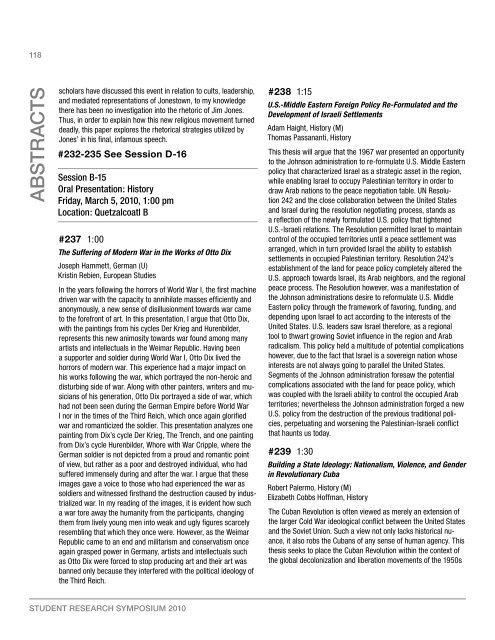STUDENT RESEaRch SympoSiUm 2010 - Graduate and Research ...
STUDENT RESEaRch SympoSiUm 2010 - Graduate and Research ...
STUDENT RESEaRch SympoSiUm 2010 - Graduate and Research ...
You also want an ePaper? Increase the reach of your titles
YUMPU automatically turns print PDFs into web optimized ePapers that Google loves.
118<br />
AbstrActs<br />
scholars have discussed this event in relation to cults, leadership,<br />
<strong>and</strong> mediated representations of Jonestown, to my knowledge<br />
there has been no investigation into the rhetoric of Jim Jones.<br />
Thus, in order to explain how this new religious movement turned<br />
deadly, this paper explores the rhetorical strategies utilized by<br />
Jones’ in his final, infamous speech.<br />
#232-235 See Session D-16<br />
Session B-15<br />
Oral Presentation: History<br />
Friday, March 5, <strong>2010</strong>, 1:00 pm<br />
Location: Quetzalcoatl B<br />
#237 1:00<br />
The Suffering of Modern War in the Works of Otto Dix<br />
Joseph Hammett, German (U)<br />
Kristin Rebien, European Studies<br />
In the years following the horrors of World War I, the first machine<br />
driven war with the capacity to annihilate masses efficiently <strong>and</strong><br />
anonymously, a new sense of disillusionment towards war came<br />
to the forefront of art. In this presentation, I argue that Otto Dix,<br />
with the paintings from his cycles Der Krieg <strong>and</strong> Hurenbilder,<br />
represents this new animosity towards war found among many<br />
artists <strong>and</strong> intellectuals in the Weimar Republic. Having been<br />
a supporter <strong>and</strong> soldier during World War I, Otto Dix lived the<br />
horrors of modern war. This experience had a major impact on<br />
his works following the war, which portrayed the non-heroic <strong>and</strong><br />
disturbing side of war. Along with other painters, writers <strong>and</strong> musicians<br />
of his generation, Otto Dix portrayed a side of war, which<br />
had not been seen during the German Empire before World War<br />
I nor in the times of the Third Reich, which once again glorified<br />
war <strong>and</strong> romanticized the soldier. This presentation analyzes one<br />
painting from Dix’s cycle Der Krieg, The Trench, <strong>and</strong> one painting<br />
from Dix’s cycle Hurenbilder, Whore with War Cripple, where the<br />
German soldier is not depicted from a proud <strong>and</strong> romantic point<br />
of view, but rather as a poor <strong>and</strong> destroyed individual, who had<br />
suffered immensely during <strong>and</strong> after the war. I argue that these<br />
images gave a voice to those who had experienced the war as<br />
soldiers <strong>and</strong> witnessed firsth<strong>and</strong> the destruction caused by industrialized<br />
war. In my reading of the images, it is evident how such<br />
a war tore away the humanity from the participants, changing<br />
them from lively young men into weak <strong>and</strong> ugly figures scarcely<br />
resembling that which they once were. However, as the Weimar<br />
Republic came to an end <strong>and</strong> militarism <strong>and</strong> conservatism once<br />
again grasped power in Germany, artists <strong>and</strong> intellectuals such<br />
as Otto Dix were forced to stop producing art <strong>and</strong> their art was<br />
banned only because they interfered with the political ideology of<br />
the Third Reich.<br />
<strong>STUDENT</strong> RESEARCH SYMPOSIUM <strong>2010</strong><br />
#238 1:15<br />
U.S.-Middle Eastern Foreign Policy Re-Formulated <strong>and</strong> the<br />
Development of Israeli Settlements<br />
Adam Haight, History (M)<br />
Thomas Passananti, History<br />
This thesis will argue that the 1967 war presented an opportunity<br />
to the Johnson administration to re-formulate U.S. Middle Eastern<br />
policy that characterized Israel as a strategic asset in the region,<br />
while enabling Israel to occupy Palestinian territory in order to<br />
draw Arab nations to the peace negotiation table. UN Resolution<br />
242 <strong>and</strong> the close collaboration between the United States<br />
<strong>and</strong> Israel during the resolution negotiating process, st<strong>and</strong>s as<br />
a reflection of the newly formulated U.S. policy that tightened<br />
U.S.-Israeli relations. The Resolution permitted Israel to maintain<br />
control of the occupied territories until a peace settlement was<br />
arranged, which in turn provided Israel the ability to establish<br />
settlements in occupied Palestinian territory. Resolution 242’s<br />
establishment of the l<strong>and</strong> for peace policy completely altered the<br />
U.S. approach towards Israel, its Arab neighbors, <strong>and</strong> the regional<br />
peace process. The Resolution however, was a manifestation of<br />
the Johnson administrations desire to reformulate U.S. Middle<br />
Eastern policy through the framework of favoring, funding, <strong>and</strong><br />
depending upon Israel to act according to the interests of the<br />
United States. U.S. leaders saw Israel therefore, as a regional<br />
tool to thwart growing Soviet influence in the region <strong>and</strong> Arab<br />
radicalism. This policy held a multitude of potential complications<br />
however, due to the fact that Israel is a sovereign nation whose<br />
interests are not always going to parallel the United States.<br />
Segments of the Johnson administration foresaw the potential<br />
complications associated with the l<strong>and</strong> for peace policy, which<br />
was coupled with the Israeli ability to control the occupied Arab<br />
territories; nevertheless the Johnson administration forged a new<br />
U.S. policy from the destruction of the previous traditional policies,<br />
perpetuating <strong>and</strong> worsening the Palestinian-Israeli conflict<br />
that haunts us today.<br />
#239 1:30<br />
Building a State Ideology: Nationalism, Violence, <strong>and</strong> Gender<br />
in Revolutionary Cuba<br />
Robert Palermo, History (M)<br />
Elizabeth Cobbs Hoffman, History<br />
The Cuban Revolution is often viewed as merely an extension of<br />
the larger Cold War ideological conflict between the United States<br />
<strong>and</strong> the Soviet Union. Such a view not only lacks historical nuance,<br />
it also robs the Cubans of any sense of human agency. This<br />
thesis seeks to place the Cuban Revolution within the context of<br />
the global decolonization <strong>and</strong> liberation movements of the 1950s


